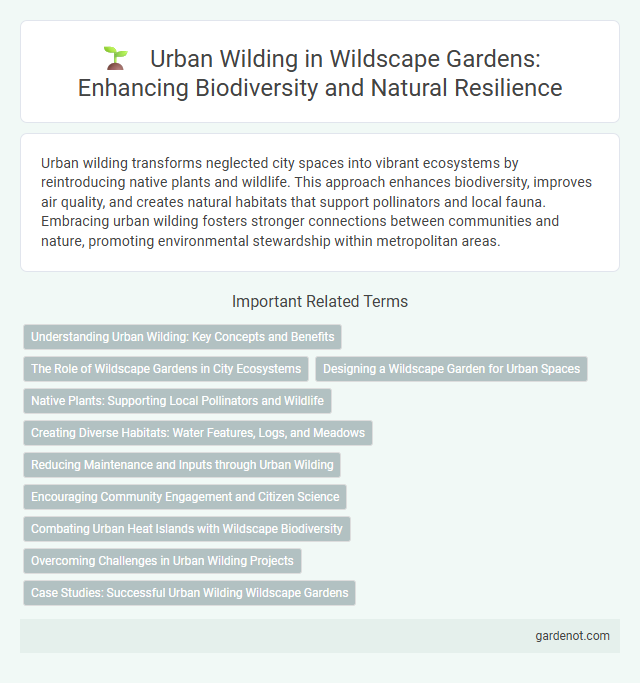Urban wilding transforms neglected city spaces into vibrant ecosystems by reintroducing native plants and wildlife. This approach enhances biodiversity, improves air quality, and creates natural habitats that support pollinators and local fauna. Embracing urban wilding fosters stronger connections between communities and nature, promoting environmental stewardship within metropolitan areas.
Understanding Urban Wilding: Key Concepts and Benefits
Urban wilding refers to the intentional reclamation and management of natural habitats within city environments, promoting biodiversity and ecological resilience. It enhances ecosystem services such as air purification, temperature regulation, and wildlife habitat provision, contributing to sustainable urban development. Integrating native vegetation and green corridors supports urban wildlife populations and improves community well-being by fostering connections with nature.
The Role of Wildscape Gardens in City Ecosystems
Wildscape gardens play a crucial role in urban ecosystems by enhancing biodiversity and supporting native species within city environments. These green spaces provide essential habitats for pollinators, birds, and small mammals, helping to maintain ecological balance amidst urban development. Integrating wildscape gardens into city planning contributes to improved air quality, natural water management, and increased resilience against climate change impacts.
Designing a Wildscape Garden for Urban Spaces
Designing a Wildscape Garden for Urban spaces involves integrating native plants that support local biodiversity and create natural habitats for pollinators and birds. Emphasizing layered vegetation and natural water features enhances ecological functions while providing aesthetic appeal and resilience against urban environmental stressors. Incorporating permeable surfaces and sustainable maintenance practices further promotes soil health and reduces runoff, making Wildscape gardens ideal for urban wilding initiatives.
Native Plants: Supporting Local Pollinators and Wildlife
Urban wilding with native plants fosters vibrant ecosystems by supporting local pollinators such as bees, butterflies, and hummingbirds, which are essential for plant reproduction and biodiversity. Native flora provides critical habitats and food sources, enhancing urban wildlife resilience and promoting ecological balance. Implementing native plant landscaping reduces maintenance needs and chemical inputs, creating sustainable green spaces that benefit both wildlife and urban communities.
Creating Diverse Habitats: Water Features, Logs, and Meadows
Creating diverse habitats in urban wildscapes enhances biodiversity by integrating water features like ponds and rain gardens that support amphibians and insects. Incorporating logs and woody debris provides shelter and breeding sites for reptiles, invertebrates, and fungi, fostering ecological complexity. Meadow areas establish native plant communities that attract pollinators such as bees and butterflies, promoting resilient urban ecosystems.
Reducing Maintenance and Inputs through Urban Wilding
Urban wilding enhances biodiversity by transforming neglected city spaces into self-sustaining ecosystems, significantly reducing maintenance costs and resource inputs. Native plant species adapted to local conditions minimize water usage, fertilizer, and pesticide needs, promoting ecological balance. These naturalized urban habitats improve soil health and support pollinators, driving long-term environmental and economic benefits.
Encouraging Community Engagement and Citizen Science
Urban wilding projects transform underutilized city spaces into thriving ecosystems, fostering biodiversity and promoting environmental stewardship. Community engagement initiatives empower residents to participate in habitat restoration and wildlife monitoring, strengthening local connections to nature. Citizen science programs facilitate data collection on urban flora and fauna, contributing to valuable ecological research and sustained conservation efforts.
Combating Urban Heat Islands with Wildscape Biodiversity
Urban wilding enhances local biodiversity through strategic planting of native flora and creation of green corridors, effectively reducing Urban Heat Island (UHI) effects. Wildscape biodiversity increases shading, improves evapotranspiration, and lowers surface temperatures, directly mitigating heat buildup in dense city environments. Incorporating diverse wildscapes into urban planning maximizes ecosystem services, promoting climate resilience and healthier urban microclimates.
Overcoming Challenges in Urban Wilding Projects
Urban wilding projects face challenges such as habitat fragmentation, limited native plant species, and human-wildlife conflicts. Effective strategies include creating green corridors, using adaptive planting techniques, and engaging local communities in stewardship. Leveraging GIS mapping and biodiversity monitoring enhances project resilience and long-term ecological success.
Case Studies: Successful Urban Wilding Wildscape Gardens
Urban wilding in Wildscape Gardens exemplifies successful reintegration of native biodiversity within city environments, promoting ecological balance and enhancing urban resilience. Case studies highlight increased populations of pollinators such as bees and butterflies, alongside the return of native bird species, demonstrating effective habitat restoration. These gardens serve as replicable models for transforming underutilized urban spaces into thriving ecosystems that support wildlife and foster community engagement.
Urban wilding Infographic

 gardenot.com
gardenot.com